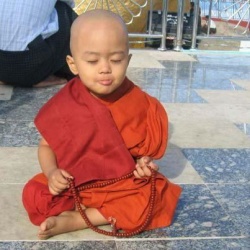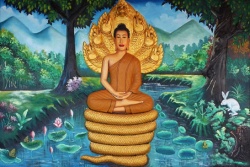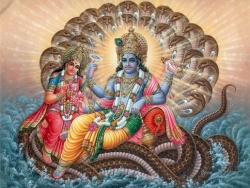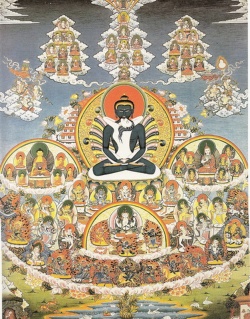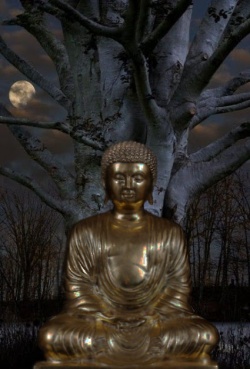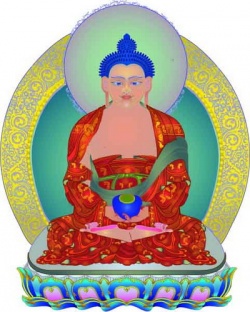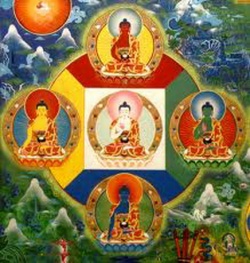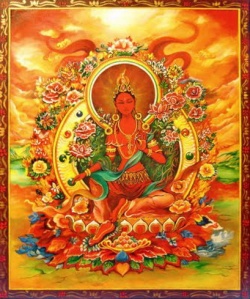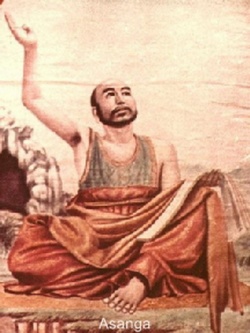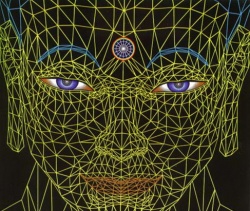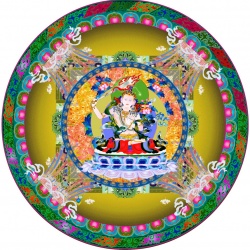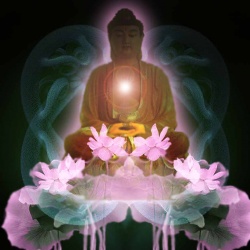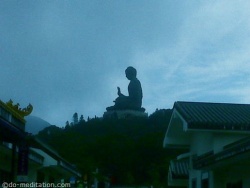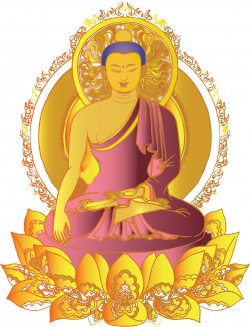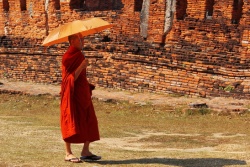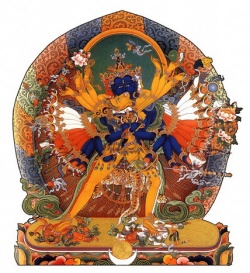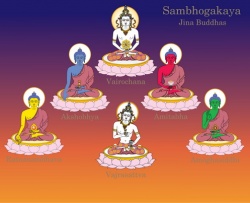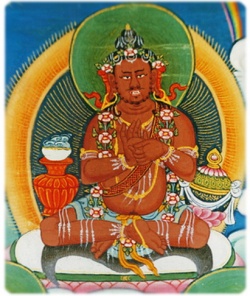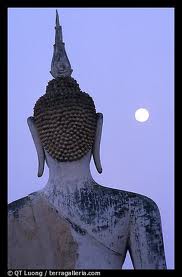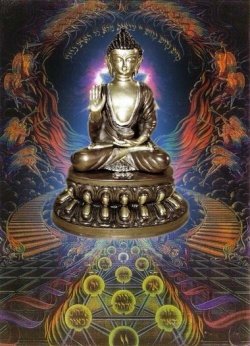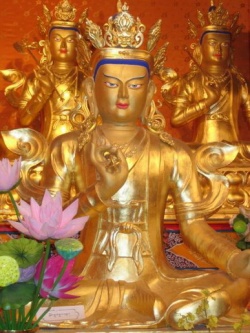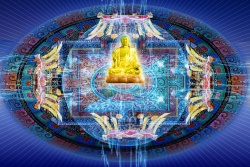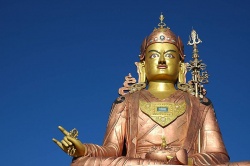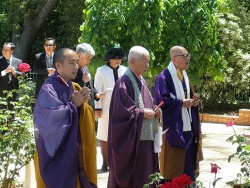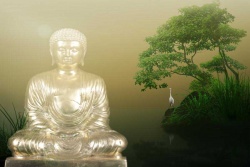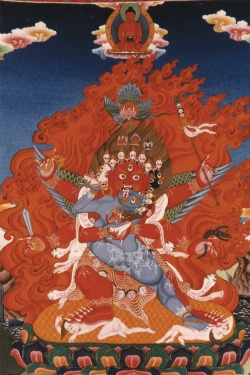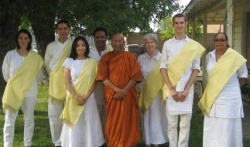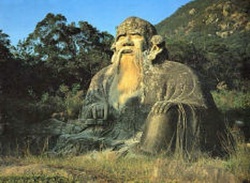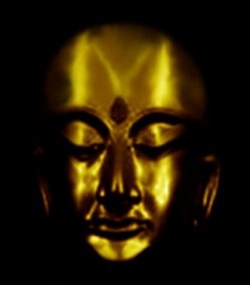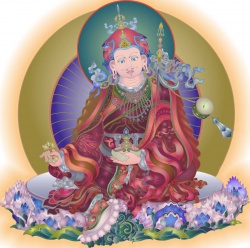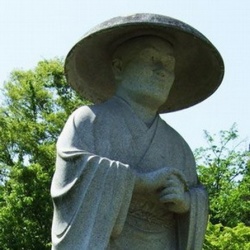The Doctrine of Non-duality in the Vimalakiirti Nirde’sa
By Dharmachari Ratnaguna
The Doctrine of Non-duality - A Restatement of the Buddha’s Teaching of The Middle Way.
One of the alternative titles for the Vimalakirti Nirdesa (Teaching of Vimalakirti) is The Reconciliation of Dichotomies [1], an idea which is scattered throughout the text, but which is exemplified most fully in chapter nine,
The Dharma Door of Non-duality, in which thirty one Bodhisattvas each propose a dichotomy, which they then resolve with a ‘Dharma Door of Non-duality’.
The chapter ends with Ma~nju’srii, the Bodhisattva of Wisdom, asking Vimalakirti to give his own ‘entrance into Non-duality’, his answer being the famous ‘thunderous silence’.
But what is duality, and what is Non-duality? And why does duality need to be resolved into Non-duality?
Duality consists (usually, but not always) of a pair of opposites, whereas non-duality is the Middle Way which is between, and which also transcends, these opposites.
In the Dhammachakkappavattana-Sutta [2], The First Turning of the Wheel of the Dharma, the Buddha taught the Middle Way between the extremes of attachment to sense pleasures on the one hand, and self-mortification on the other - the Middle Way between the two being the Noble Eightfold Path leading to Enlightenment.
This teaching is a practical application of the central insight of Buddhism, an insight which is put in metaphysical terms in another discourse - the Kaccayanagotta-Sutta.[3]
In this sutta Kaccayana asks the Buddha what he means by the term right view (sammaa-di.t.thi) and the Buddha answers “This world, Kaccaayana, usually bases [its view] on two things: on existence and on non-existence....... Everything exists:- this is one extreme.
Nothing exists:- this is the other extreme.
Not approaching either extreme, the Tathaagata teaches you a doctrine by the middle [way].” [4]
But what did the Buddha mean by existence and non-existence?
Existence (atthitaa) means absolute existence - that is the idea that things have eternal existence, and need no other conditions for their existence.
Non-existence is absolute non-existence - that is, things don’t have any existence at all - they are completely illusory.
The Middle Way between and above these two extremes is expressed in the doctrine of Conditioned co-production (pra.titya-samutpaada) which states that all things arise in dependence on conditions, and cease when those conditions cease.
Things have neither absolute existence nor absolute non-existence - they have relative existence.
Vimalakiirti, like The Buddha , is not concerned with philosophical problems for their own sake.
His main concern is the alleviation of suffering, which is achieved by treading the path to Enlightenment, so the question arises, what does this metaphysical discussion have to do with suffering and its alleviation?
The answer occurs in chapter 5 of the text - The Consolation of the Invalid.
Vimalakiirti is ill, or at least pretends to be, his illness being a metaphor for suffering (dukkha).
At one point he says,
Thus, recognizing in his own suffering the infinite sufferings of these living beings, the Bodhisattva correctly contemplates these living beings and resolves to cure all sicknesses.
As for these living beings, there is nothing to be applied, and there is nothing to be removed; one has only to teach them the Dharma for them to realize the basis from which sicknesses arise.
What is this basis?
It is object perception.
Insofar as apparent objects are perceived, they are the basis of sickness.
What things are perceived as objects?
The three realms of existence are perceived as objects.
What is the thorough understanding of the basic, apparent object? It is its non-perception, as no objects exist ultimately.
What is non-perception? The internal and the external object are not perceived dualistically. Therefore, it is called nonperception.[5]
What Robert Thurman translates as ‘object perception’, Sara Boin, in her English rendering of Etienne Lamotte’s French translation, uses ‘the grasping of an object’. Thus:
What is the foundation of sickness?
The foundation of sickness is the grasping of an object. This grasping being the foundation, as long as there is grasping, there is sickness.[6]
I have quoted Boin’s rendering of Lamotte’s French because it makes clear the connection between the metaphysical and the practical levels of the Middle Way: because we imagine that things have absolute existence, we grasp them.
In other words we have in this statement of Vimalakiirti the first two of the Four Noble Truths: Sickness = suffering (dukkha). Object perception = grasping (ta.nhaa).
So far then Vimalakiirti’s message is the same as the Buddha’s - the extremes of attachment to sense pleasures and self-mortification, and absolute existence and absolute non-existence, are to be avoided and transcended.
The first through following the path to Enlightenment, the second by thoroughly comprehending the truth of Conditioned Co-production.
However, Vimalakiirti takes the idea further than this:
What is the elimination of sickness? It is the elimination of egoism and possessiveness.
What is the elimination of egoism and possessiveness? It is the freedom from dualism.
What is freedom from dualism?
It is the absence of involvement with either the external or the internal.
What is absence of involvement with either external or internal?
It is nondeviation, nonfluctuation, and non-distration from equanimity.
What is equanimity? It is the equality of everything from self to liberation.
Why? Because both self and liberation are void. How can both be void?
As verbal designations they are both void, and neither is established in reality.
Therefore one who sees such equality makes no difference between sickness and voidness; his sickness is itself voidness, and that sickness as voidness is itself void.[7]
In the first part of this statement we are still on very familar ground: suffering arises due to egoism (aatmagraaha - self-grasping) and possessiveness (aatmiiyagraaha - grasping that which I believe to be mine).
To overcome this we need to overcome the duality of ‘involvement with the external and the internal’[8] - the belief in an enduring and separate self on the one hand, and the corresponding belief in enduring and separate objects on the other.
How do we do this?
Through “nondeviation, nonfluctuation, and nondistraction from equanimity.”
Here Vimalakiirti introduces a crucial idea in the text, one which stretches the Buddha’s practical teaching of the Middle Way between opposites to include all categories whatsoever.
“Equanimity” in Thurman’s translation Lamotte Sanskritizes as samataa, which means sameness, and this sameness includes
everything from self to liberation (Nirvaa.na). Why? Because both self and liberation are void. How can both be void?
As verbal designations (naamadheya) they are both void.[9]
Verbal designations, or concepts, are all the same because they are all empty - empty that is, of absolute existence.
Therefore the ideas (verbal designations) of both self and Enlightenment are a duality which has to be transcended.
Once Vimalakiirti has said this, he is free to set up any (and all) categories as dualistic, including all the categories of the Dharma, which is exactly what he does.
He does this because at every stage of the path to Enlightenment the practitioner is confronted with the two extremes of existence and non-existence at ever more subtle levels.
The skilful treading of the path consists in recognizing these subtle dichotomies and choosing the Middle Way between, or better, above them.
Existence and non-existence are basic categories of thought and we can’t help but think in those terms, even when talking about ideas or experiences which transcend those categories.
So, even though the Buddhist is aware that Nirvaa.na is neither eternal existence nor annihilation, he cannot help but imagine it to be, in some subtle way, either one or the other of these two options, that is, as being either an eternal continuation or the annihilation of the self.
(The literature of the Paali Canon tends to veer towards non-existence in its depiction of Enlightenment, even though there are many passages which deny this, whereas some of the Mahaayaana schools tend to depict it as a state of eternal existence). Skill In Means.
Vimalakiirti’s resolution of dichotomies is one of the aspects of his Skill In Means (Upaaya kau’salya), which is the Bodhisattva’s ability to adapt the Buddha’s teaching to suit the capabilities, inclinations, and spiritual development of whoever he is talking to.
In other words, skill in means is the skill to teach the Dharma appropriately. Vimalakiirti himself is a master of this skill - in fact he is the supreme exemplar of it.
In chapter two, called Inconceivable Skill In Means (acintya upaaya kau’salya) the text tells us that
He was liberated through the transcendence of wisdom.
Having integrated his realization with skill in means, he was expert in knowing the thoughts and actions of living beings.
Knowing the strength or weakness of their faculties, and being gifted with unrivalled eloquence, he taught the Dharma appropriately to each.[10]
Throughout the text we see him employing this skill again and again, and we see him exhorting others, Disciples and Bodhisattvas, to do the same.
In chapter two, Inconceivable Skill In Means, we meet him for the first time, and we see him pretending to be ill.
This is itself a Skill In Means in order to get the people of the city of Vai’saalii to visit him so that he can teach them the Dharma.
To them he gives a teaching on the unsatisfactoriness of the physical body:
Friends, this body is so impermanent, fragile, unworthy of confidence, and feeble.
It is so insubstantial, perishable, short-lived, painful, filled with diseases, and subject to changes.
Thus, my friends, as this body is only a vessel of many sicknesses, wise men do not rely on it.
And thus he goes on for two paragraphs, ending with
Therefore, you should be revulsed by such a body. You should despair of it and should arouse your admiration for the body of the Tathaagata..[11]
What is this body of the Tathaagata?
Friends, the body of the Tathaagata is the body of Dharma, born of gnosis.
The body of a Tathaagata is born of the stores of merit and wisdom.
It is born of morality, of meditation, of wisdom, of the liberations, and the knowledge and vision of liberation.
It is born of love, compassion, joy, and impartiality. It is born of charity, discipline, and self-control.[12]
And so on for a full paragraph.
Here Vimalakiirti is pointing out the dichotomy of attachment to sense pleasures, and its inevitable concommitant - suffering.
The Middle Way between the two is the aspiration for the Body of the Tathaagata - a body which is not physical, and so not subject to physical pain.
At the beginning of chapter three Vimalakiirti thinks
I am sick, lying on my bed in pain, yet the Tathaagata, the saint, the perfectly accomplished Buddha, does not consider me or take pity on me, and sends no-one to enquire after my illness.[13]
The Buddha knows what Vimalakirti is thinking, and proceeds to ask each of the disciples (500 in all) and the Bodhisattvas (how many?
The text doesn’t tell us) to visit Vimalakiirti.
Every one of them admits that they are reluctant to visit Vimalakiirti, and to explain their reluctance they each tell a story of a time when Vimalakiirti approached them as they were practising or teaching the Dharma.
In each case he took them to task for practising or teaching wrongly, that is, inappropriately.
It was not that any of the practices they were enaged in, or teachings they were giving, were wrong in themselves, it was that they were not appropriate - they were not suited to the people who were practising or hearing the Dharma at that time.
In chapter five, The Consolation of the Invalid, the Buddha at last finds someone who is willing to visit him - Ma~nju’srii, the Bodhisattva of Wisdom.
Even Ma~nju’srii, we are given to believe, has to overcome his reluctance -
Lord, it is difficult to attend upon the Licchavi Vimalakiirti.
He is gifted with marvellous eloquence concerning the law of the profound. He is extremely skilled in full expressions and in the reconciliation of dichotomies.
His eloquence is inexorable, and no one can resist his imperturbable intellect....
Thus, although he cannot be withstood by someone of my feeble defences, still, sustained by the grace of the Buddha, I will go to him and converse with him as well as I can.[14]
The Vimalakiirti Nirde’sa is a drama, and here the tension is being built up - Ma~nju’srii, the Bodhisattva of Wisdom, is about to meet Vimalakiirti. What is going to happen?
Thereupon in that assembly, the Bodhisattvas, the great disciples, the ‘Sakras, the Brahmaas, the Lokapaalas, and the gods and the goddesses, all had this thought: ‘Surely the conversations of the young prince Ma~nju’srii and that good man will result in a profound teaching of the Dharma’[15],and they all follow Ma~nju’srii to listen.
Vimalakiirti, meanwhile, is lying sick on his couch, but he knows that Ma~nju’srii is coming and transforms his house into emptiness.
Even the doorkeeper disappeared.
And, except for the invalid’s couch upon which Vimalakiirti was lying, no bed or couch could be seen anywhere.[16]
This is not only dramatic, it is also highly significant.
Vimalakiirti has just been teaching the good people of Vai’saalii about the suffering inherent in the physical body, and exhorting them to aspire to the body of the Tathaagata.
Now he transforms his house into emptiness.
Emptiness, (‘suunyataa) is non-dualistic.
It is beyond the realm of this and that, good and bad, skilful and unskilful.
In transforming his house into emptiness Vimalakiirti is preparing us for a shift in the content of his teaching, and it comes immediately:
Ma~nju’srii! Welcome Ma~nju’srii! You are very welcome!
There you are, without any coming.
You appear, without any seeing. You are heard, without any hearing.”
Ma~nju’srii declared, “Householder, it is as you say.
Who comes, finally comes not.
Who goes, finally goes not. Why? Who comes is not known to come. Who goes is not known to go. Who appears is finally not to be seen. [17]
What does this mean? Vimalakiirti and Ma~nju’srii are giving expression to the fact that, as far as they are concerned, such ideas as Vimalakiirti, Ma~nju’srii, coming, appearing, seeing, hearing, and going, are empty - they are merely ‘verbal designations’, and as such not to be taken very seriously.
We have moved from the simple Middle Way of the Buddha’s teaching to the more philosophically sophisticated Non-duality of the Perfection of Wisdom literature.
Ma~nju’srii then comes to the point of his visit - he asks Vimalakiirti about his sickness, and Vimalakiirti utters what has become, in China and Japan, a very famous reply:
Ma~nju’srii, my sickness comes from ignorance and the thirst for existence and it will last as long as do the sicknesses of all living beings.
Were all living beings to be free from sickness, I also would not be sick.
Why? Ma~nju’srii, for the Bodhisattva, the world consists only of living beings, and sickness is inherent in living the world.
Were all living beings free of sickness, the Bodhisattva would also be free of sickness.....
Ma~nju’srii, the Bodhisattva loves all living beings as if each were his only child.
He becomes sick when they are sick and is cured when they are cured. You ask me, Ma~nju’srii, whence comes my sickness; the sickness of the Bodhisattvas arise from great compassion.[18]
(Remember that sickness here is a metaphor for suffering (dukkha).
Try substituting the word sickness for suffering in the above and other passages where Vimalakiirti is expounding on sickness and notice the effect.)
Ma~nju’srii then asks Vimalakiirti a number of questions, one of which is “Householder, how should a Bodhisattva console another Bodhisattva who is sick?” Vimalakiirti’s reply is very important:
He should tell him that the body is impermanent, but should not exhort him to renunciation or disgust.
He should tell him that the body is painful, but should not encourage him to find solace in liberation.[19]
This is rather different to what Vimalakiirti said in chapter two, to the people of Vai’saalii.
There, you will remember, he told them that the body was impermanent, painful and insubstantial, and that they should therefore feel revulsion for it, renounce their attachment to it,
and should aspire to the Body of the Tathaagata, which is liberation.
Here though, in speaking to a Bodhisattva he says that, although the body is impermanent, he should not exhort him to renunciation or disgust.
Even though the body is painful (dukkha), he should not encourage him to find solace in liberation. What should he do then?
He should encourage his empathy for all living beings on account of his own sickness, his remembrance of suffering experienced from beginningless time, and his consciousness of working for the welfare of living beings.[20]
To the people of Vaisali Vimalakiirti points out the suffering inherent in having a physical body so that they will aspire to Enlightenment.
To the Bodhisattvas he does so so that they will feel compassion for other living beings - just as they suffer, so all other living beings suffer, so rather than aspire to Enlightenment for their own sake, they should try to alleviate the suffering of others.
However, Vimalakiirti is not here telling Bodhisattvas to choose a path of altruism instead of the path to Enlightenment.
That would be to choose one side of a dichotomy rather than another and Vimalakiirti is the great reconciler of dichotomies.
Ma~nju’srii’s next question allows Vimalakiirti to explain further what he means. He asks
Noble sir, how should a sick Bodhisattva control his own mind?
Vimalakiirti replies, Ma~nju’srii, a sick Bodhisattva should control his own mind with the following consideration: Sickness arises from total involvement in the process of misunderstanding from beginningless time.
It arises from the passions that result from unreal mental constructions, and hence ultimately nothing is perceived that can be said to be sick.
Why? The body is the issue of the four main elements, and in these elements there is no owner and no agent.
There is no self in this body, and, except for arbitrary insistence on self, ultimately no ‘I’ which can be said to be sick can be apprehended........
What is the elimination of this sickness? It is the elimination of egoism and possessiveness. What is the elimination of egoism and possessiveness?
It is the freedom from dualism.[21]
The Bodhisattva’s compassion is based on Wisdom - the Wisdom which sees through the deluded notion of a separate self, from which delusion there arises the apparent dichotomy of either gaining Enlightenment or helping others.
A little later in the text Vimalakiirti makes this clear in a passage about bondage and liberation, in which he stresses the importance of integrating Wisdom and Skill In Means.
What is bondage, and what is liberation? To indulge in liberation from the world without employing skill in means is bondage for the bodhisattva.
To engage in life in the world with full employment of skill in means is liberation for the bodhisattva....
Wisdom not integrated with skill in means is bondage, but wisdom integrated with skill in means is liberation.
Skill in means not integrated with wisdom is bondage, but skill in means integrated with wisdom is liberation.[22]
In other words, any ideas of gaining Enlightenment for oneself without also helping others result in bondage, not liberation.
Conversely, any ideas about helping others without also working one one’s own spiritual development also result in bondage.
Both sides of that dichotomy result in bondage because they are based on false notions of self and other, which is the basis of all ‘sickness’, i.e. suffering.
The Dharma Door To Non-duality
Vimalakiirti though, is not content to restrict his teachings to reconciling the basic duality of self and other, and throughout the text many other dualities are ‘reconciled’.
This reconciliation of dichotomies is explored most fully in Chapter nine, The Dharma Door of Non-duality, where Vimalakiirti asks the Bodhisattvas present to “explain how the Bodhisattvas enter the Dharma-door of Non-duality.”[23]
Thirty one Bodhisattvas, including Ma~nju’srii, give their own sets of dualities, which they then reconcile into Dharma Doors of Non-duality.
For instance,
The Bodhisattva ‘Sriigandha declared, ‘“I” and “mine” are two.
If there is no presumption of a self, there will be no possessiveness.
Thus, the absence of presumption is the entrance into nonduality.[24]
Other Bodhisattvas take different Dharmic categories:
The Bodhisattva ‘Saantendriya declared, ‘It is dualistic to say ‘Buddha’, ‘Dharma’, and ‘Sa.ngha’.
The Dharma is itself the nature of the Buddha, the Sangha is itself the nature of the Dharma, and all of them are uncompounded.
The uncompounded is infinite space, and the processes of all things are equivalent to infinite space.
Adjustment to this is the entrance into nonduality.’[25]
The Bodhisattva Subaahu declared,
‘Bodhisattva-spirit’ (bodhisattvacitta) and ‘Disciple-spirit’ (‘sravakacitta) are two.
When both are seen to resemble an illusory spirit (citta), there is no Bodhisattva-spirit, nor any Disciple-spirit.
Thus the sameness of natures of spirits is the entrance into nonduality.’[26]
So far this is quite uncontroversial.
However, some of the Bodhisattvas say some quite shocking things, apparently demolishing Buddhism itself. Ma.nikuu.taraaja, for instance, says,
It is dualistic to speak of good paths (maarga) and bad paths (kumaarga).
One who is on the path (maarga) is not concerned with good or bad paths.
Living in such unconcern, he entertains no concepts of ‘path’ or ‘nonpath’.
Understanding the nature of concepts, his mind does not engage in duality.
Such is the entrance into nonduality.[27]
Or Vidyuddeva, who says,‘Knowledge’ (vidya) and ‘ignorance’ (avidyaa) are dualistic.
The natures of ignorance and knowledge are the same, for ignorance is undefined, incalculable, and beyond the sphere of thought.
The realization of this is the entrance into nonduality.[28]
Or Ti.sya, who says,‘Good’ (ku’sala) and ‘evil’ (aku’sala) are two.
Seeking neither good nor evil, the understanding of the nonduality of the significant and the meaningless is the entrance into nonduality.[29]
Why should they say such things? What do they mean, and of what benefit could they be to anyone?
One of the Vimalakiirti Nirde’sa’s main concerns is to try to get people to let go of their various attachments, and this is really all that Vimalakiirti himself does throughout the whole of the text - his Skill In Means consists solely in encouraging, cajoling,
and exhorting people to go forth from their attachments, whatever they are, and to take the next step in their spiritual development, whatever that might be.
In the Paali Canon there is a list of four kinds of attachment (upaadaana)[30], and it may be useful see the Vimalakiirti Nirde’sa as an assault on each of these.
They are: attachment to sensuous pleasures (kaama); to views (di.t.thi); to ethics (siila) and external observances (bbata) merely for their own sakes; and to the belief in a ‘soul’ or unchanging essence to phenomena (attavaada).
Depending on who he is talking to Vimalakirti tries to get his hearers to give up one or more of these attachments.
So, for instance, in the second chapter he encourages the people of Vai’saalii to give up their attachment to their physical bodies, which are the source of both sensuous pleasure and suffering, and also, to a large extent, their belief in a fixed and separate self.
In the following chapters, when he is speaking to Disciples and Bodhisattvas, he tries to get them to let go of the last three kinds of attachment: to views; ethics and external practices (merely for their own sakes); and self-view - it being understood that they have already renounced attachment to sensuous desire.
So when ‘Saariputra is meditating at the foot of a tree Vimalakiirti tells him that he is meditating wrongly:
You should absorb yourself in contemplation in such a way that you can manifest all ordinary behaviour without forsaking cessation.
You should absorb yourself in contemplation in such a way that you can manifest the nature of an ordinary person without abandoning your cultivated spiritual nature.[31]
‘Saariputra has got attached to a ‘view’ about meditation - that it consists in the rejection and abandonment of certain aspects of life, when meditation is actually the embracing of all.
When Mahaamaudgalyaayana is teaching the Dharma to some householders Vimalakiirti tells him that he is teaching them wrongly, i.e. with the idea that there is a really existent self teaching really existent people:
there is no teacher of the Dharma, no one to listen, and no-one to understand.
It is as if an illusory person were to teach the Dharma to illusory people.[32]
Mahaamaudgalyaayana is still subtly attached to the notion of a self. Mahaakaa’syapa is famous for his asceticism, and made it his practice to beg food only from the poor - these being in more need of merit than the rich.
This is what he is doing when Vimalakiirti confronts him, telling him that he is guilty of “partiality in benevolence”, and that he should
dwell on the fact of the equality of things, and ... should seek alms with consideration for all living beings at all times.[33]
Mahaakaa’syapa has become attached to external observances.
It is important to remember that here, as in all other parts of the text, Vimalakirti is practising Skill In Means - he is adapting the Dharma to the capabilities, inclinations, and spiritual development of whoever he is talking to.
What he says to ‘Sariputra, Mahamaudgalyayana, and Mahaka’syapa is probably not what he would say to you or I.
‘Saariputra is meditating in the forest, Mahamaudgalyayana is teaching the Dharma, and Mahakasyapa is practising renunciation and compassion.
These are very skilful actions which the vast majority of Buddhists would do well to try to put into practice.
Because Vimalakiirti points out the limitations of their respective practices to these three great disciples, this should not give us any reason for not practising, or for giving up our practice prematurely.
Nor should it give us any reason to feel superior to the Disciples - if we feel that then we have completely missed the point the text is trying to make.
On the contrary, we should feel the greatest respect, admiration and devotion towards them.
After all, how many of us have reached their level of spiritual development? How many of us are ready for such teachings that Vimalakiirti gave to them? In criticizing them in these ways Vimalakiirti is paying them the highest compliment.
Let us return now to the ninth chapter, The Dharma-Door of Non-Duality, and try to understand the Bodhisattvas statements in the light of all I have just said. Once again, it is important to remember the context of these statements - who is talking to who?
Bodhisattvas are speaking to Bodhisattvas, and they are very advanced Bodhisattvas:
Their mindfulness, intelligence, realization, meditation, incantation, and eloquence were all perfected. They were free of all obscurations and emotional involvements, living in liberation without impediment....
They were expert in knowing the spiritual faculties of all living beings....They were experts in the way of the Dharma....
They were endowed with the wisdom that is able to understand the thoughts of living beings, as well as their comings and goings.… [34].
Each of the Bodhisattvas’ Dharma Doors are concerned with letting go of attachment to views, many of them views about the Dharma - about the spiritual life.
In the Mahaacattaariisaka Sutta[35] the Buddha discusses three kinds of view (di.t.thi): wrong view, and two kinds of right view:
there is right view that is affected by the taints, partaking of merit, ripening on the side of attachment; and there is right view that is noble, taintless, supramundane, a factor of the path.
The first kind of right view is that understanding of the Dharma which has not yet been informed by Transcendental Insight, while the second kind has.
In a sense the second kind of right view is not a view at all, in the sense of an opinion, or doctrine, but is a direct understanding of Reality.
So there is a hierarchical arrangement: we have to move from wrong view to the first kind of right view, and from there to the second kind of right view.
One of the characteristics of the first kind of right view is that it ripens “on the side of attachment” - we can possess right view while at the same time being subject to attachment, including, presumably, attachment to views, even right views.
This attachment to right views, although helpful in the early stages of our development, later becomes a hindrance, because we have eventually to let go of all attachments, even skilful ones.
The Buddha makes this clear in his Parable of the Raft,[36] when he says,
You should understand, monks, from the Parable of the Raft that good things (dhamma) must be left behind, much more so evil things (adhamma).[37]
We need the raft to cross over the river, but once we reach the other side we have to leave it behind.
The Bodhisattvas in the Vimalakiirti Nirde’sa are very close to Enlightenment - they are at the stage where they need to start leaving the raft behind. To leave the raft behind means to let go of one’s attachment to it.
The Bodhisattvas have to let go of their attachment to those doctrines and practices which have helped them progress on the path - not let go of the doctrines and practices themselves:
The Bodhisattva Ma.nikuu.taraaja declared, ‘It is dualistic to speak of good paths (maarga) and bad paths (kumaarga). One who is on the path (maarga) is not concerned with good or bad paths.
Living in such unconcern, he entertains no concepts of ‘path’ or ‘nonpath’. Understanding the nature of concepts, his mind does not engage in duality.
Such is the entrance into non-duality’.
In his first sentence Ma.nikuu.taraaja proposes ‘good paths’ and ‘bad paths’ as a duality which has to be reconciled. In his next he says that he who is on the path is not concerned with good paths or bad paths.
The word Thurman translates as ‘good path’ is the same as the one he translates as ‘path’ - maarga. Presumably he does this to show that the Bodhisattva who is on the path does not make a conceptual distinction between good paths and bad paths.
But in doing this he obscures a very important point - that it is only from the viewpoint of the ‘good path’ that the Bodhisattva is able to see through the conceptual distinction between ‘good paths’ and ‘bad paths’.
It is not that the Bodhisattva leaves the path, it is that he has let go of his attachment to the concept of the path.
Put in another way the Bodhisattva has moved from the first kind of right view - that is “right view that is affected by taints, partaking of merit, ripening on the side of attachment” - to the second kind, “right view that is noble, taintless, supramundane.”
If this all seems rather abstract, perhaps a mundane analogy would help.
Someone learning to drive a car has to think about each action that they make - turn the ignition key while pressing down a little with the right foot on the accelarator,
press left foot down on the clutch, get into first gear, take off handbreak, look into mirror to see if it is safe to pull out, if it is, put on right hand indicator, press down a litttle more on the accelerator with right foot, and, simultaneously,
slowly release pressure from clutch with left foot; as the car starts moving forwards, turn the steering wheel with both hands slightly to the right ...etc.
I have been driving cars for 25 years and I do all that automatically, so much so that to write down what I do has cost me some effort of memory and analysis.
I may even have made a few mistakes in writing it down, although when I drive I invariably do it all effortlessly, unselfconsciously, and correctly.
The Buddhist who is consciously practising the good path is analogous to the learner-driver, whereas the Bodhisattva who is not concerned with the practice of the path is like the skilful driver who no longer thinks (conceptually) about practising the path - he just does it.
The analogy is not perfect - even the experienced driver can make a mistake and cause a bad accident, whereas the Bodhisattva who has gone beyond good paths and bad paths will always act skilfully, for it has become his nature.
The Bodhisattva Vidyuddeva is talking from the same standpoint when he says
‘Knowledge’ (vidyaa) and ‘ignorance’ (aavidyaa) are dualistic.
The natures of ignorance and knowledge are the same, for ignorance is undefined, incalculable, and beyond the sphere of thought.
The realization of this is the entrance into non-duality.
When he says that knowledge and ignorance both have the same natures he does not mean that they have the same value, and that we may just as well be ignorant as wise.
After all, ignorance is suffering: “Sickness (suffering) arises from total involvement in the process of misunderstanding from beginningless time”[38] and the Vimalakiirti Nirde’sa, like all Buddhist texts, is concerned to alleviate ignorance because it is concerned to alleviate suffering.
Vidyuddeva means that someone who possesses Knowledge (the second kind of right view) lets go of his attachment to the concepts of knowledge and ignorance. But he can only do that because he is wise - someone who is ignorant cannot afford to let go of the concept of knowledge.
We can understand the Bodhisattva Ti.sya’s statement in the same way:
‘Good’ (ku’sala) and ‘evil’ (aku’sala) are two. Seeking neither good nor evil, the understanding of the non-duality of the significant and the meaningless is the entrance into non-duality.
I have already mentioned the Buddha’s threefold distinction of wrong view and the two kinds of right view.
Elsewhere the Buddha makes a similar distinction, but in terms of ethical behaviour (siila): here the disciple has to move from unethical behaviour to ethical behaviour, at which point unethical behaviour ‘ceases without remainder’.
But he then has to move to the point where even ethical behaviour ‘ceases without remainder’.
In answer to the question ‘where do skilful moral actions (kusala-sila) cease without remainder?’ the Buddha replies: when one ‘possesses virtue (silavant), not when one is regulated by virtue (silamaya).’[39] One who possesses virtue no longer has to practice virtue - they have become virtuous.
Chapter nine ends with a climax, and it is the climax of the whole text.
When thirty Bodhisattvas have all proposed their own Dharma Doors of Non-Duality they ask Ma~nju’srii to give his own Dharma Door. He replies,
Good sirs, you have all spoken well. Nevertheless, all your explanations are themselves dualistic.
To know no one teaching, to express nothing, to say nothing, to explain nothing, to announce nothing, to indicate nothing, and to designate nothing - this is the entrance into nonduality.[40]
Ma~nju’srii then asks Vimalakiirti to give his own entrance in the Dharma Door of Non-duality, and
the Licchavi Vimalakiirti kept his silence, saying nothing at all.
The crown prince Ma~nju’srii applauded the Licchavi Vimalakiirti: “Excellent! Excellent, noble sir! This is indeed the entrance into nonduality of the Bodhisattvas.
Here there is no use for syllables, sounds, and ideas.[41]
The Danger of Pseudo Non-duality
Although this is the climax of the text, it is not the end - there are three chapters left, and the next chapter, ‘The Feast Brought by the Emanated Incarnation’ is very significant.
Vimalakiirti magically emanates an incarnation-Bodhisattva and sends him to the universe Sarvagandhasugandhaa (Sweetly Perfumed with all Perfumes) to ask the Buddha of that universe, Sugandhakuu.ta (Mountain of Perfume) for the remains of his meal.
The ninety-million Bodhisattvas of that universe wish to go back with the incarnation-Bodhisattva to see the Buddha ‘Saakyamuni, Vimalakiirti and the other Bodhisattvas, and they ask the Buddha Sugandhakuu.ta for permission.
He allows them to go, but warns them to go without their perfumes, “lest those living beings become mad and intoxicated”.[42]
The incarnation-Bodhisattva, along with the ninety-million Bodhisattvas, returns to this universe with the remains of Sugandhakuu.ta’s meal, and Vimalakiirti invites ‘Sariputra and the other great disciples to eat it, which they do, as do all the Bodhisattvas, ‘Sakras, Brahmaas, Lokapalas, gods and goddesses.
As a result of eating this food they all experience great bliss, and a wonderful perfume pervades from the pores of their skin. Vimalakiirti then asks the Bodhisattvas from Sarvagandhasugandhaa how their Buddha teaches the Dharma. They reply,
The Tathagata does not teach the Dharma by means of sound and language.
He disciplines Bodhisattvas only by means of perfumes.
At the foot of each perfume-tree sits a Bodhisattva, and the trees emit perfumes like this one.
From the moment they smell that perfume, the Bodhisattvas attain the concentration called ‘source of all Bodhisattva-virtues’.
From the moment they attain that concentration, all the Bodhisattva-virtues are produced in them.[43]
Those Bodhisattvas then ask Vimalakirti how the Buddha of this universe, ‘Sakyamuni, teaches the Dharma. He replies,
Good sirs, these living beings here are hard to discipline.
Therefore he teaches them with discourses appropriate to the disciplining of the wild and uncivilized.
How does he discipline the wild and uncivilized?
What discourses are appropriate? Here they are: ‘This is hell.
This is the animal world.
This is the world of the lord of death.
These are the adversities.
These are the rebirths with crippled faculties.
These are physical misdeeds, and these are the retributions for physical misdeeds.
These are verbal misdeeds, and these are the retributions for verbal misdeeds.
These are mental misdeeds, and these are the retributions for mental misdeeds.
This is killing.
This is stealing. This is sexual misconduct.
This is lying.
This is backbiting. This is harsh speech.
This is frivolous speech.
This is covetousness. This is malice. This is false view.
These are their retributions. This is miserliness, and this is its effect. This is immorality.
This is hatred. This is sloth.
This is the fruit of sloth.
This is false wisdom, and this is the fruit of false wisdom.
These are the transgressions of the precepts.
This is the vow of personal liberation.
This should be done and that should not be done.
This is proper and that should be abandoned.
This is an obscuration and that is without obscuration. This is sin and that rises above sin.
This is the path and that is the wrong path.
That is virtue and that is evil.
This is blameworthy and that is blameless. This is defiled and that is immaculate.
This is mundane and that is transcendental. This is compounded and that is uncompounded. This is passion and that is purification.
This is life (sa.msaara) and that is liberation (nirvaa.na)’.[44]
This is one of the most powerful passages in the whole book, not least because of where it comes in the text.
After all those Bodhisattvas’ statements on Non-duality, ending with Vimalakiirti’s ‘thunderous silence’, we have come to inhabit a rarefied world where all dualistic distinctions are refined away to nothing.
This is followed by the episode in which the emanated incarnation travels to the wonderful universe of perfumes, where Bodhisattvas sit at the foot of perfume-trees, imbibing the Dharma by means of beautiful fragrances - an image which strengthens our sense of subtle non-dualism and adds to it the refined attractions of beauty and pleasure.
At this point Vimalakiirti brings us down to earth with an unpleasant shock, reminding us of the suffering involved in the world, and warning us not to let go of our dualistic frameworks prematurely.
Highly advanced Bodisattvas may be able to play with the concepts of good paths and bad paths, knowledge and ignorance, good and evil, but we badly need them.
We see things dualistically and we must hold fast to the positive side of the duality, otherwise we suffer:
This is hell. This is the animal world. This is the world of the lord of death.
These are the adversities. These are the rebirths with crippled faculties.
This reminds me of another of the Buddha’s teachings - the Parable of the Water Snake, which the Buddha used, significantly, just before he told the Parable of the Raft.[45]
A man goes in search of a water snake, finds one, and grabs it by the tail.
The snake rears round and bites the man, and he suffers agonizing pain before eventually dying of the poisoned bite.
Another man goes in search of a water snake, finds one, but carefully catches it by the neck so that it cannot bite him.
The first man is like the man who misunderstands the Dharma - it causes him suffering.
The second man is like the one who understands the Dharma - he comes to no harm.
Naagaarjuna used this simile in his Verses on the Middle Way, when he warned that a wrong grasp of the doctrine of Emptiness (‘suunyataa) will lead to suffering,[46] and the same could be said about the doctrine of Non-duality in the Vimalakiirti Nirde’sa.
The passage I have just quoted is Vimalakiirti’s warning to us, and the danger is very real.
Conclusion
I have argued that the doctrine of Non-duality is essentially a re-statement of the Buddha’s teaching of the Middle Way.
However, I have also stated that the Vimalakiirti Nirde’sa takes this doctrine further than did the Buddha, stretching the application of it to include all concepts whatsoever, including those (necessarily dualistic) concepts which constitute the doctrines of Buddhism.
Whereas the Buddha spoke simply of the Middle Way between the extremes of indulgence in sense pleasures and self-mortification, or, more metaphysically,
between (absolute) existence and (absolute) non-existence, the Vimalakiirti Nirde’sa teaches the Middle Way (Dharma Door of Non-duality) between such things as skilful and unskilful, knowledge and ignorance, good paths and bad paths.
This ‘stretching’ of the idea of Non-duality is dangerous, the danger being that people reading the text may assume that such teachings are appropriate to their level of spiritual development when they are not.
Of course that danger is often present when we read a Buddhist text, even in the ‘basic’ or ‘simple’ teachings of the Buddha that we find in the Pali Canon.
(That is why the Buddha told the parable of the water snake).
When we read those texts we should constantly bear in mind that the Buddha was often talking to a particular person, and what may be good for that person may not be good for us.
However, the danger inherent in The Vimalakiirti Nirde’sa’s Dharma Doors of Non-duality is particularly acute, because to some people it could appear to be saying that all those doctrines and practices which make up the Buddhist path to Enlightenment are to be discarded because they are dualistic:
there is no difference between good paths and bad paths, skilful and unskilful actions, knowledge and ignorance.
Hence, some Buddhists may dismiss such ‘basic’ teachings as the five precepts, or the necessity for renunciation, with the retort “Oh, but that is dualistic isn’t it?”
Or “There is no path, and no-one to tread it”.
Such a misunderstanding is tantamount to seizing the poisonous water snake by the tail, or stepping off the raft in midstream, only to drown in the deep waters of Sa.msaara.
If the teachings in the Vimalakiirti Nirde’sa such as those in chapter nine are only for advanced Bodhisattvas and Arahants, not for ordinary Buddhists, the question could be asked, is there any point in us reading and studying it (assuming that we are neither advanced Bodhisattvas nor Arahants)?
I think there is, as long as we do not assume that all the teachings in it are meant for us.
First of all, the text is a great piece of Buddhist literature - it is profound, moving, funny, shocking, and inspiring.
Vimalakiirti himself is a wonderful character, absolutely uncompromising, delighting in taking the ground from underneath the feet of the mighty, but with a light touch, with great wit and humour.
But what about those teachings meant for advanced Bodhisattvas and Arahants? I have just referred to the humour in the text.
Usually the humour is at the expense of one of the great Arahants or Bodhisattavas, as Vimalakiirti exposes the limitations of their way of practising, or their literal mindedness.
There is no reason why we shouldn’t sit back and laugh at these episodes - they are meant to be enjoyed.
But it might also be useful if we asked ourselves what Vimalakiirti might say to us if he turned up at our place one day - which particular weakness, attachment, or pretension would he expose to ridicule?
There is one more thing we can gain from reading this text. I have pointed out that in chapter nine, The Dharma Door of Non-duality, highly advanced Bodhisattvas are talking to highly advanced Bodhisattvas.
However, they have an audience - 500 great disciples, as well as a great number of ‘Sakras, Brahmaas, Lokapaalas, and many hundreds of thousands of gods and goddesses are listening, and I assume that not all of these beings are spiritually advanced.
What can they, (or we), get from listening to these Bodhisattvas expound on Non-duality?
It is worth listening to great minds conversing even though we may not understand what they say, or put into practice what they do.
It is valuable because, although we may not understand them, we are able to catch a glimpse of a reality far beyond our own.
The great Bodhisattvas are leaving the raft.
We must hang on to it for the time being.
But it can be very inspiring to watch them step off it onto the other shore.
In reading the Vimalakiirti Nirde’sa we are witnessing living beings of all kinds - with differing capacities, inclinations,
and at different levels of spiritual development,
from the people of Vai’saalii, to the gods and goddesses,
to the great Disciples and Arahants - we are witnessing them letting go of their attachments and experiencing a new freedom.
In watching them we take our own place in the spiritual hierarchy, and can ourselves be inspired to let go of our own particular attachments and take our next step towards freedom.
For this process to be most effective I would recommend that the whole text be read in a ritual context, that is, in the context of meditation, chanting, and ritual.
Listening to a good reading of chapter nine, for instance, in a concentrated and devotional state of mind can be an extraordinary experience - at least I have found it so.
At first, as the first few Bodhisattvas propose and resolve different sets of dualities, your discursive mind tries its best to follow them.
After a few minutes however, it becomes too much - there are too many of them coming too quickly, one after another - and you eventually have to give up and relax into a calm, non-discursive state in which you can hear what is being said, but you are not thinking about each statement.
In this state of mind it is possible to get a feeling for, even to catch a glimpse of, a mind which has let go of everything - a mind which is completely free.
[2] According to tradition the first and, by implication, the most fundamental teaching by the Buddha. Sa.myutta-Nikaaya, v. 420.
[3] Sa.myutta Nikaaya. ii, 17.
[4] Trans. Woodward. Paali Text Society.
[5] P. 45 of Robert Thurman’s translation. Pennsylvania State University Press.
I have used Thurman’s translation throughout, except where stated.
I have also used alternative renderings to some of Thurman’s translations of key terms. See for instance, note 10.
[6] P. 124. Paali Text Society.
From the French translation by Etienne Lamotte, rendered into English by Sara Boin.
There are no extant versions of the original Sanskrit text - Thurman and Lamotte have translated from
Tibetan and Chinese translations. Lamotte ‘Sanskritises’ all the key terms, in this case the term being adhyaalambana - alambana meaning object, adhya meaning to move towards.
Therefore both Thurman’s and Lamotte/Boin’s translations are correct, although Lamotte/Boin’s brings out the Buddhist connotation - there is nothing wrong with ‘perception’ in itself, it is the ‘grasping’ that causes suffering.
[7] P. 45 (Thurman’s translation).
[8] External = bahirdhaad.r.s.tii. Internal = adhyaatmad.r.s.ti.
[9] Ibid. p. 45.
[10] P.20. I have used the term ‘skill in means’ in place of Thurman’s ‘liberative technique’.
Lamotte Sanskritises the term into upaaya kau’salya..
[11] P. 22.
[12] P. 23.
[13] P. 24.
[14] P. 42.
[15] P. 42.
[16] P. 43.
[17] P. 43.
[18] P. 43.
[19] P. 44. I have changed Thurman’s ‘miserable’ to ‘painful’ (dukkha).
[20] P.44.
[21] P.45.
[22] P.46.
[23] P.73.
[24] P.73.
[25] P.75. Here is an example of a ‘duality’ made up not of opposites, but of a triad of complementaries - in this case, the Three Jewels - the highest values for all Buddhists.
[26] P.73.
[27] P.76.
[28] P.74.
[29] P.74.
[30] See, for instance, Sammaadi.t.thi Sutta, Mn. i.50.
[31] P.24.
[32] P.25.
[33] P.26.
[34] P.10.
[35] Mn. iii.70 Wisdom Publications. Translation by ~Naa.namoli and Bodhi.
[36] Alagadduupama Sutta. MN.i.135.
[37] Damien Keown’s translation, from The Nature of Buddhist Ethics. P. 101. From chapter 4, ‘The Transcendency Thesis’
Here Keown argues that the idea that ethics is merely a stage on the path that eventually has to be left behind stems from a misunderstanding of the Parable of the Raft, based on I.B. Horner’s interpretation..
In telling his disciples that they have to leave the raft behind the Buddha is not, according to Keown, saying that an Enlightened being is ‘beyond good and evil’.
He is saying that we have, at some point in our spiritual lives, to renounce our attachment even to Buddhist practices.
[38] P.45.
[39] Sama.nama.ndikaaputta Sutta (MN. ii.27). Robert Morrison’s translation, from Nietzsche and Buddhism. OUP.
[40] P.77.
[41] P.77.
[42] P.80.
[43] P.81.
[44] P.82.
[45] Alagadduupama Sutta. MN. i.133. It is significant that the Buddha told the Parable of the Water Snake just before the Parable of the Raft, because in doing so he made it clear that the doctrines and practices have to be grasped first of all.
Only later in our spiritual careers should we let go of them.
[46] Mulamadhyamakarika. XXIV.11.
